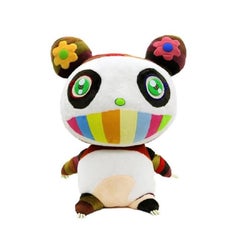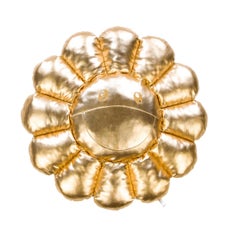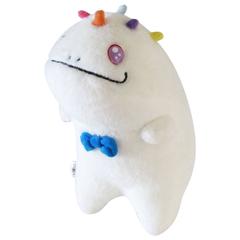Takashi Murakami Plush
Hiropon II Bear Solar Citizen Watch, Plush by Takashi Murakami
By Takashi Murakami
Located in Long Island City, NY
Artist: Takashi Murakami, Japanese (1962 - )
Title: Hiropon II Bear Solar Citizen Watch
Year
Category
1990s Pop Art More Art
Materials
Polyester
$2,250
H 7 in W 8 in D 6 in
Panda Plush Large
By Takashi Murakami
Located in Washington , DC, DC
Panda Plush Large
Category
21st Century and Contemporary Contemporary Sculptures
Materials
Cotton
Recent Sales
Takashi Murakami - Flower Plush Pillow, GOLD, 60 cm
By Takashi Murakami
Located in New York, NY
Takashi Murakami x Kaikai Kiki Flower Plush Pillow
Shiny gold fabric Takashi Murakami 24" flower
Category
21st Century and Contemporary Contemporary Sculptures
Materials
Fabric
H 23.63 in W 23.63 in D 1.19 in
Takashi Murakami Soft Sculpture, 2007
By Takashi Murakami
Located in Los Angeles, CA
Fun, fuzzy friend by Takashi Murakami, Anime style, fantasy creature, plush toy, art doll made in
Category
21st Century and Contemporary Japanese Modern Animal Sculptures
Takashi Murakami Soft Black Skull Sculpture, 2007
By Takashi Murakami
Located in Los Angeles, CA
Fun, fuzzy skull by Takashi Murakami, black fantasy creature, plush toy, art doll made in Japan
Category
21st Century and Contemporary Japanese Modern Animal Sculptures
Takashi Murakami Pop Flower Ball Plush 2008 Ltd Edition Collector's Art Basel
By Takashi Murakami
Located in Keego Harbor, MI
For your consideration is a phenomenally whimsical, plush, polyester flowerball, by Takashi
Category
Early 2000s Japanese Abstract Sculptures
KAWS Holiday Plush Companions (KAWS holiday complete set of 3)
By KAWS
Located in NEW YORK, NY
figurative. KAWS Holiday. Takashi Murakami. KAWS Companion. KAWS plush.
Category
21st Century and Contemporary Pop Art Figurative Sculptures
Materials
Cotton
Takashi Murakami Flower Plush 30cm (Silver)
By Takashi Murakami
Located in London, GB
'Flowers' by Takashi Murakami x KaiKai Kiki, 2020
Silver colorway.
11.8 Inches diameter.
Plush
Category
21st Century and Contemporary Pop Art Sculptures
Materials
Nylon
Takashi Murakami Flower Ball Plush 2008 Limited Edition Collector's Art Basel
By Takashi Murakami
Located in New York, NY
Takashi Murakami Flower Ball Plush 2008.
Seen as object decor at Pharrell Williams "Because I
Category
21st Century and Contemporary Unknown Decorative Objects
Plush 60 cm Flower Cushion
By Takashi Murakami
Located in London, GB
24” x 24”
'As new' condition.
Category
21st Century and Contemporary Contemporary More Art
Materials
Nylon
KAWS Holiday Companion set (KAWS plush holiday complete set of 3)
By KAWS
Located in NEW YORK, NY
2006 and 2013.
Related Categories:
KAWS figurative. KAWS Holiday. Takashi Murakami. KAWS Companion
Category
21st Century and Contemporary Pop Art Figurative Sculptures
Materials
Cotton
KAWS Holiday Companion set (KAWS plush holiday complete set of 3)
By KAWS
Located in NEW YORK, NY
2006 and 2013.
Related Categories:
KAWS figurative. KAWS Holiday. Takashi Murakami. KAWS Companion
Category
21st Century and Contemporary Pop Art Figurative Sculptures
Materials
Cotton
Takashi Murakami - Flower Plush Pillow, GOLD
By Takashi Murakami
Located in New York, NY
Takashi Murakami x Kaikai Kiki Flower Plush Pillow
Shiny gold fabric Takashi Murakami 24" flower
Category
21st Century and Contemporary Contemporary Sculptures
Materials
Fabric
Takashi Murakami - Flower Plush Pillow, GOLD, 30 cm
By Takashi Murakami
Located in New York, NY
Takashi Murakami x Kaikai Kiki Flower Plush Pillow
Shiny gold fabric Takashi Murakami 30cm flower
Category
21st Century and Contemporary Contemporary Sculptures
Materials
Fabric
H 11.82 in W 11.82 in D 1.19 in
People Also Browsed
Sakura and Panda
By Takashi Murakami
Located in Bristol, GB
Offset print with silver and high gloss varnishing
Edition of 300
Signed and numbered on the front
Excellent, with a soft crease on the left edge
Our mission is to connect art colle...
Category
21st Century and Contemporary Contemporary More Prints
Materials
Offset, Lithograph
Takashi Murakami Kanye West 2007 (Takashi Murakami Louis Vuitton)
By Takashi Murakami
Located in NEW YORK, NY
Takashi Murakami, Kanye West, Louis Vuitton; Los Angeles 2007 (Murakami Gala):
Rare folding invitation published on the occasion of a 2007 reception honoring Takashi Murakami and fa...
Category
21st Century and Contemporary Pop Art Abstract Prints
Materials
Offset, Paper
Get Updated with New Arrivals
Save "Takashi Murakami Plush", and we’ll notify you when there are new listings in this category.
Takashi Murakami Plush For Sale on 1stDibs
On 1stDibs, you can find the most appropriate takashi murakami plush for your needs in our varied inventory. Find Contemporary versions now, or shop for Contemporary creations for a more modern example of these cherished works. If you’re looking to add a takashi murakami plush to create new energy in an otherwise neutral space in your home, you can find a work on 1stDibs that features elements of beige, gray, orange and more. Creating a takashi murakami plush has been a part of the legacy of many artists, but those crafted by Takashi Murakami are consistently popular. Artworks like these — often created in fabric, nylon and synthetic — can elevate any room of your home.
How Much is a Takashi Murakami Plush?
The average selling price for a takashi murakami plush we offer is $2,086, while they’re typically $1,016 on the low end and $12,345 for the highest priced.
More Ways To Browse
Louis Xvi Rug
Oyster Chandelier
Vintage Bear Toy
Boho Chandelier
Theatre Mirror
Memphis Style Mirror
Korean Ceramic Plates
Theatre Backdrop
Pink Silk Chair
Lilac Chair
Pink Postmodern Chair
Brass Pakistan
Tudor Mirror
French Verdigris Chandelier
Large Moroccan Chandelier
Georgian Crystal Chandelier
Tudor Style Chandelier
Brass Moroccan Mirror


